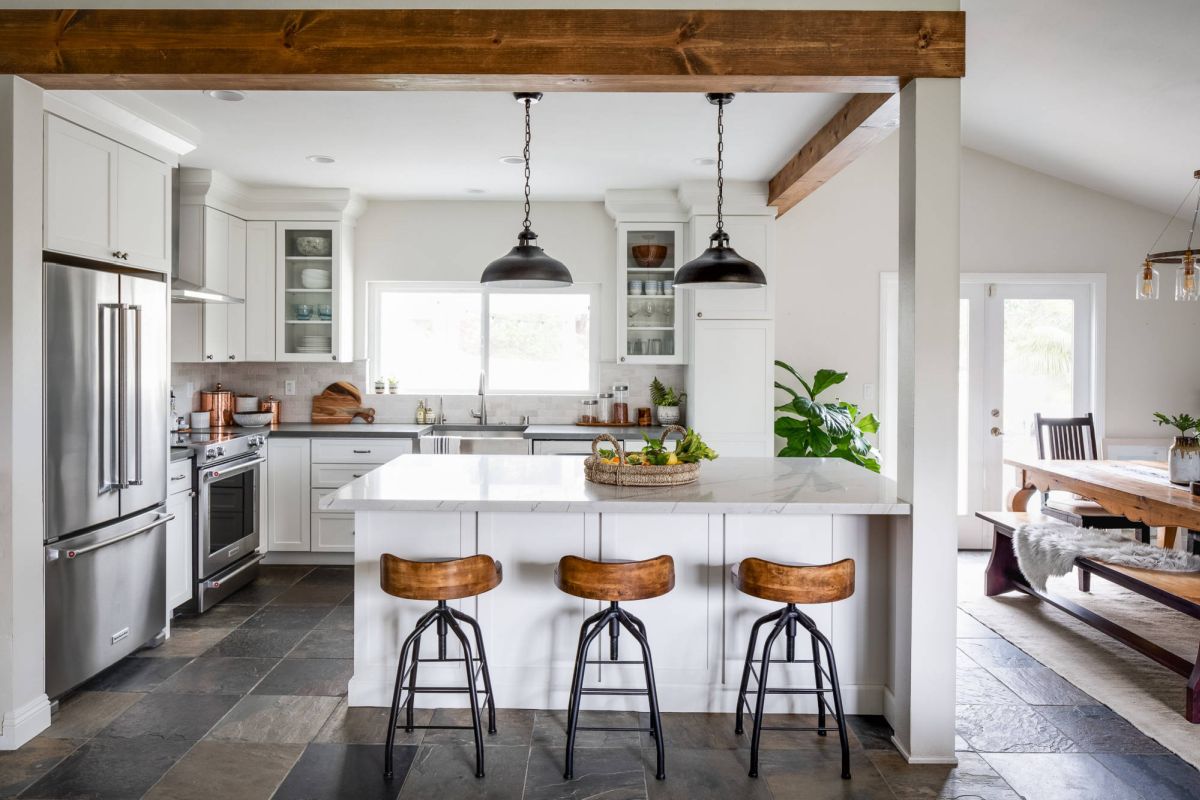Many experts consider a slate kitchen floor one of the weightier types for a kitchen area. Slate is durable, water-resistant, less expensive than other natural stones, and beautiful. It is moreover versatile in style.

According to Livingetc, slate is a “timeless flooring option that can squint good in any style property, modern or traditional.”
Slate Kitchen Floor: Pros and Cons

Most people love the squint and finger of a slate kitchen floor, but nothing is perfect for everyone. Consider this quick list of the benefits and drawbacks of this gorgeous stone to decide if slate kitchen flooring might be a good option for you.
Pros:
- Beauty – Slate flooring has a varied coloring from gray to vibrant hues. It is a textured stone for rustic style kitchens or can be sanded smooth for increasingly modern styles.
- Durability – Slate is a natural stone that has innate strength and tautness to resist unrepealable damage. With proper care, slate flooring can last for as long as the life of your home.
- Investment – Natural stone flooring is lulu to other home buyers and can increase your return on your home investment.
- Water Resistance – Slate flooring is water and stain-resistant making it an platonic nomination for kitchen flooring.
- Cost – Slate floors are less expensive than other natural stone floor varieties like marble or granite.
- Easy Regular Maintenance – The regular maintenance required for kitchen slate floor tiles is sweeping or dry-mopping each day and wet-mopping virtually every month.
Cons:
- Repair – In severe cases, slate kitchen floor tiles can be damaged or broken. It is difficult to replace the wrenched tiles without breaking the surrounding ones.
- Installation – Slate is nonflexible but moreover brittle. Slate floor tiles are increasingly difficult than other tiles like porcelain for DIYers to install considering the subfloor must be level in order to alimony the top layer of slate from cracking.
- Cost – Slate is increasingly expensive than synthetic floor options like vinyl or laminate.
- Sealing – Slate flooring must be sealed each year in order to alimony the porous natural stone from titillating water and other substances. m
- Scratching – Slate floors are easy to scratch. Therefore, this is not a suitable flooring type for a room where its floors are subject to heavy abuse.
- Hardness – Slate is a nonflexible flooring material which can be difficult to stand on for long lengths of time. It is moreover less forgiving when you waif objects on it.
What is Slate?

Slate is a fine-grained, layered metamorphic waddle that has been worked from a shale-type waddle made from soil or volcanic ash.
Slate moreover contains quartz, feldspar, calcite, pyrite, and hermite. Slate is worked with heat and pressure which causes these minerals to line up parallel to each other and form the layers which indulge slate to split into sheets.
Most slate is a deep gray color, but there is moreover slate misogynist in green, red, brown, black, and purple. Slate flooring can be found in exterior as well as interior spaces considering of its strength, beauty, and durability.
Types of Slate Flooring for Kitchen Design
By far, the most worldwide type of kitchen slate flooring is tiles. These have a variety of styles and finishes that you can purchase.
Slate Kitchen Tile Types
There are three main types of tile styles: gauged, ungauged, and calibrated.
- Gauged Tiles – Gauged slate tiles are ground lanugo or cut on the marrow side of the tile with the top side remaining textured or uncut to alimony its rustic quality.
- Ungauged Tiles – Ungauged tiles are left rough and uneven on both sides. These are “tiles” in their most natural state. They remain non-uniform in both size and thickness. These are most often used outdoors.
- Calibrated – Calibrated slate tiles are ground lanugo on the top and the marrow to present a increasingly uniform style. These have a smoother visitation which is often used in increasingly modern or trendy style kitchens.
Slate Kitchen Tile Finishes
Slate tile manufacturers have a variety of tile finishes that you can choose. The most popular finishes are polished, honed, tumbled, and clefted.
- Polished Slate Tile – Fabricators sand polished slate tiles to create a smooth and tight textured surface. This creates a increasingly slippery surface so this finish does not work well if you have small children who are increasingly wrecking prone.
- Honed Slate Tile – Honed slate tiles are moreover finished to create a smooth surface but not unbearable to create a shine. These slate tiles have increasingly grip, so they work largest in rented areas like kitchens.
- Tumbled Slate Tile – The surface of tumbled slate tiles have some texture and variation, but the edges and the surface have been softened.
- Clefted Slate Tile – Clefted slate tiles are the most rough and textured of these four types. It is moreover tabbed natural slate and is used in rustic and traditional kitchen settings.
Cleaning a Slate Floor and Other Maintenance
In a rented and zippy room like a kitchen, it is vital to understand how to superintendency for the floor and to alimony it clean.
- Clean Each Day – It is important to alimony your slate tiles self-ruling from pebbles and trash that can build up on a slate floor and rationalization scratching lanugo the road. Each day, sweep or dry-mop the floor.
- Wet Mopping – Every month or so, or when you have been uneaten messy with supplies prep, mop the slate floors with a cleaning solution with a natural pH. Do not use any cleaners with lemon or vinegar. Let them air-dry or use a soft reticulum to vitrify them dry.
- Sealing a Slate Floor – It is weightier to maintain a regular schedule for sealing your slate floor tiles for kitchen spaces. Segregate a sealer with the type of finish you want from matte to glossy. Wipe the slate and indulge it and the grout in between the tiles to dry for 24 hours. Pour the sealer into a roller pan. Wield the sealer with a foam roller or sponge. Indulge the sealer to dry for 24 hours surpassing you walk on it.
- Special Cases – If your slate floor scratches, wield mineral spirits which may hibernate the scratch. Use felt pads on the marrow of furniture to minimize the scratching potential. Wipe up spills as they occur to stave staining. If staining does occur, use a stone poultice to try to remove the stain.
Slate Kitchen Floor Ideas for Design
A slate floor kitchen is most worldwide in farmhouse and rustic design, but there are moreover modern kitchens that use slate. We have rounded up some examples of variegated types of kitchens that use slate flooring.
Farmhouse Slate Kitchen Floor

A farmhouse kitchen with slate floor is a ubiquitous diamond feature, but it gets a twist in the farmhouse space.
In this kitchen design, Plain & Posh diamond visitor uses a multi-colored square slate tile for the flooring. The gorgeous and varied tile complements the neutral surf and dusky undecorous farmhouse kitchen cabinets.
Mid Century Modern Slate Kitchen Floor

This mid-century modern kitchen gets a uplift in style with a multi-tile sized slate floor. The floor does not just hoist the squint of the kitchen, it provides flipside texture to weigh the wood cabinets and white walls.
Contemporary Kitchen With Slate Floor Tiles

In general, you might not think to pair slate floors with trendy kitchens. But in this design, Partners 4 Diamond combines the rectangular slate tiles with trendy elements like the white well-to-do cabinets and the waterfall island in a seamless way.
This diamond emphasizes each smooth slate floor tile with contrasting white grout for a increasingly modern look.
Rustic Slate Flooring Kitchen Design

Rustic and historic-style kitchens squint wondrous with slate tile flooring. If you want the most rustic floor, use a clefted or a tumbled slate tile. These will have the most texture and provide the most “aged” squint of all the tile options.
The slate tile floor in this rustic kitchen grounds the space which allows the designers to use light colored wood and white walls in the kitchen and still squint balanced.
Transitional Kitchen With Slate Flooring

The multi-colored slate tile in this kitchen works to tousle all the disparate foundational elements in this transitional kitchen. It complements the wood detailing, the white cabinets, and pops of woebegone and copper.
Frequently Asked Questions (FAQ)FAQ
What is the most inexpensive type of kitchen slate floor?
According to HomeAdvisor, the forfeit of the stereotype slate tile flooring ranges from $4-$10 per square foot. For high-end slate, you can pay from $15-$28 per square foot. Installation runs between $10-$16 per square foot. If you want to save money in your slate kitchen floor, try to find increasingly slate that was mined closer to the surface which is less expensive and moreover consider ways to install the slate tile yourself. Make sure that you build a solid subfloor surface that is level surpassing you install your tile or your tile can one-liner later on.
Is slate a good nomination for a kitchen floor?
Slate is a trappy natural stone that works well in kitchens considering it stands up to heavy foot traffic and is easy to alimony clean. On the other hand, it is moreover nonflexible and can rationalization your feet to hurt and rationalization increasingly breakages from objects dropping on it. If you like the squint of slate floors, you can add thick rugs to help in places where you will need to stand for lengthy periods of time.
What are the main sizes of slate floor tiles?
Slate tiles come in both regular and irregular shapes. Square slate tiles come in sizes ranging from 6”x 6” all the way up to 24”x 24”. Rectangular slate tiles moreover vary in size from small sizes like 3”x 6” up to 18”x 24”.
Are slate kitchen floors still in style?
Slate tile is the type of flooring that never goes out of style. While it may be increasingly or less trendy at unrepealable times, slate kitchen floors have unchangingly had and will unchangingly have many fans.
What is the weightier kind of rustic slate floor tiles?
If you are looking for a rustic style slate floor, segregate gauged or ungauged tiles with a clefted or tumbled finish.
Conclusion
Slate kitchen floors are a archetype and elegant nomination for any home kitchen. These floors have a timeless quality that can maintain their squint as other trends come and go.
Slate tiles are durable, water-resistant, and beautiful. Slate tiles in your kitchen moreover provide a unconfined return on your investment when you decide that it is time to move on to flipside home.
The post Slate Kitchen Floor Designs: Pros and Cons appeared first on Homedit.
